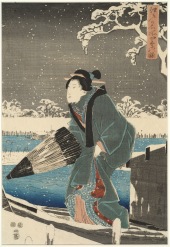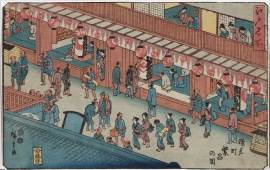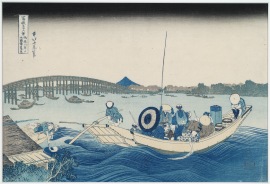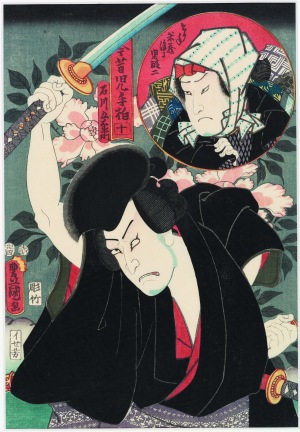 Roughly
150 years ago in Europe, Impressionist and young Post- Impressionist
artists were first delighting in the ukiyo-e,
wood-block prints from Japan.
Roughly
150 years ago in Europe, Impressionist and young Post- Impressionist
artists were first delighting in the ukiyo-e,
wood-block prints from Japan.
These images portrayed popular Japanese actors and courtesans, illustrated well-known stories and plays, showed views of landscapes with everyday people, and documented scenes from ordinary life. These inexpensive prints were wildly popular in Japan, and became a huge influence on 19th Century European artists. These prints changed art history, and as surprising as they seem now, they were even more startling in mid-19th Century Europe.
Art at that time was generally deliberate, controlled, and very finished. The highest subject matter was of historical or mythological scenes. Daily life was often considered vulgar or mundane. The Japanese wood-block prints provided the young Europeans with completely new ideas and a fresh artistic alternative in color, perspective, and space in representing their modern society. The prints matched the vision of many Western artists of the time, who were also concerned with the modern experience and the new urban culture. It's a bit like comic books or urban graffiti inspiring a new generation of artists. And the freshness of their look has not diminished in time.
 Van
Gogh painted Japanese prints into the background of some of his
paintings. Gauguin loved their strong colors and patterns, and lack
of shadows. Toulouse Lautrec was an enthusiastic buyer and used their
designs, their large, empty spaces, and flat, off-center forms in his
great posters of the Moulin Rouge life of Paris. James McNeill
Whistler was inspired by the Hiroshige prints that he once owned.
Monet avidly collected the prints and displayed them in his home.
Countless other artists
benefited from their fresh example.
Van
Gogh painted Japanese prints into the background of some of his
paintings. Gauguin loved their strong colors and patterns, and lack
of shadows. Toulouse Lautrec was an enthusiastic buyer and used their
designs, their large, empty spaces, and flat, off-center forms in his
great posters of the Moulin Rouge life of Paris. James McNeill
Whistler was inspired by the Hiroshige prints that he once owned.
Monet avidly collected the prints and displayed them in his home.
Countless other artists
benefited from their fresh example.
After viewing the exhibit of 30 Japanese prints currently at the Figge Art Museum, one can see why so many artists have lingered over the images of these fleeting moments and pleasures of life - what the Japanese called "The Floating World."
 A
wood-block print starts with the artist's drawing, which is then
pasted down to a smooth piece of wood, generally cherry, and given to
a carver who cuts out the images with engraving tools. Everything is
opposite in a print; what is carved out or taken away will not print,
and what is left in will.
A
wood-block print starts with the artist's drawing, which is then
pasted down to a smooth piece of wood, generally cherry, and given to
a carver who cuts out the images with engraving tools. Everything is
opposite in a print; what is carved out or taken away will not print,
and what is left in will.
Then ink is rolled over the surface, and a paper is placed over the inked wood and rubbed to create the image. A different block is used for each color.
These prints served the same function as our fashion magazines today, informing us of current styles of the famous and the fashionable. They are art today for the same reason as great photographs: the artist's exquisite eye and technical skill in capturing a subtle and elusive moment in time.
Of the many Japanese ukiyo-e artists, six are represented in this exhibit from the Figge's permanent collection. Among the greatest were Hiroshige (1797-1858) and Hokusai (1760-1849).
Katsushika Hokusai used some 30 different names over his life, because artists in Japan at the time would change their "art name" whenever they changed their style or medium. His first name came from his master. He gradually emerged as one of the most popular and prolific artists of his time, creating more than 30,000 drawings, paintings, and prints. He died at age 89, with his brush in his hand. He said that if he only had another five years to live, he just might become a great artist. The final name he gave himself, Gaky-rajin, means "the art crazy old man."
 Hokusai's
Man Playing Flute is
a scene from a rest station/hotel along a national road where
travelers could stop and refresh or stay overnight. The image shows a
seated flute player partially concealed behind a woman who is engaged
in an agitated conversation with a man who sits on an elevated porch,
his leg dangling over the edge. The woman looks up from her book.
Behind them, two animated trees sway in the distance. The flutist
plays his music, accompanying and describing the conversation between
the couple, and also the two trees. He acts as the artist himself, in
seeing, describing, and commenting on a momentary experience.
Hokusai's
Man Playing Flute is
a scene from a rest station/hotel along a national road where
travelers could stop and refresh or stay overnight. The image shows a
seated flute player partially concealed behind a woman who is engaged
in an agitated conversation with a man who sits on an elevated porch,
his leg dangling over the edge. The woman looks up from her book.
Behind them, two animated trees sway in the distance. The flutist
plays his music, accompanying and describing the conversation between
the couple, and also the two trees. He acts as the artist himself, in
seeing, describing, and commenting on a momentary experience.
Hokusai's Viewing Sunset Over Ryoguku Bridge is a striking landscape in reds and grays of a bridge swinging low over a river on the far left, and a large boat of working people in the center. His nuanced description with delicate decorative lines of the waves around the boat in the foreground is delicious, the way an artist would describe music or the long flow of hair. Each figure on the boat suggests a particular type of person - interacting, waiting, or oblivious to the moment they are in together. A tall pole pierces the stripes of the horizon. At the top, a long smudge of ink, wiped with a cloth, describes the sky, moving the eye back into the scene below. The subtlety of the artist is in what experience he selects from thousands that occur before him. The meaning comes from his technical skill and the way he organizes the spaces for us to see.
 The
great artist Hiroshige, whom the painter Pissarro described as "a
marvelous Impressionist," is well represented in the show with more
than a dozen prints. One, titled Travelers
Surprised by a Sudden Rain,
shows six people reacting sharply to a sudden downpour as they walk
along a narrow dirt road. The strong diagonal in the foreground,
cutting down across the picture from the left, was later used in
paintings by Toulouse Lautrec and Manet. Three layers of gray trees
slow our eyes, leading us back a short distance to a small village of
roofed houses. The rain is shown by slanting lines across the image,
reminiscent of Rembrandt's storm etching, for these Japanese
artists had been influenced by the prints from 16th and 17th Century
Europe brought to them by Dutch traders. The total effect is a
charming and humorous look at the universal human situation of being
overwhelmed by nature's unpredictability.
The
great artist Hiroshige, whom the painter Pissarro described as "a
marvelous Impressionist," is well represented in the show with more
than a dozen prints. One, titled Travelers
Surprised by a Sudden Rain,
shows six people reacting sharply to a sudden downpour as they walk
along a narrow dirt road. The strong diagonal in the foreground,
cutting down across the picture from the left, was later used in
paintings by Toulouse Lautrec and Manet. Three layers of gray trees
slow our eyes, leading us back a short distance to a small village of
roofed houses. The rain is shown by slanting lines across the image,
reminiscent of Rembrandt's storm etching, for these Japanese
artists had been influenced by the prints from 16th and 17th Century
Europe brought to them by Dutch traders. The total effect is a
charming and humorous look at the universal human situation of being
overwhelmed by nature's unpredictability.
Another Hiroshige print, Fudo Waterfall, shows a strong column of water pouring down to a small lake. The central cascading waterfall is printed in tones of dark to light blue, like a column of shining blue light. Just stepping into the water is a round, middle-aged man ready to cool off from the summer heat. Across the top hangs a row of lanterns, for night swimming. Scatterings of supporting players like fallen leaves add syncopation to the image. The composition is perfect, surprising us in its freshness, even now. The print beautifully contrasts the natural and the human.
Lady with a Parasol, the excellent postcard piece of the exhibition by Hiroshige, presents an elegant woman, covered in layers of beautiful clothing, her face shown in a few lines, her hair a large detailed and ornate construction. She holds a closed umbrella, and steps as lightly as snowfall over a snow-covered landscape. Over her head, branches, full of snow, float before a white star- and snow-filled sky. The graduations of dark to light blue water behind her are balanced by the dark to light gray in the evening sky. Up close we can see the tiny details of color and lines; stepping back they all blend into patterns of attractive abstract forms, in an unsuspected and pleasing way, like unfamiliar music striking an immediate chord of appreciation in the listener.
 Numerous
other prints call out for our attention. One of them is Kumisada's
Actors from Konjiyakuji
Tegashiwa. As in
Elizabethan theatre, men played all the parts, and Japanese actors
had tremendous followings. Their images, as characters in the plays,
were published in editions of thousands soon after a production
started. They sold out like the posters of a movie star. In the
print, we see the grimacing actor holding a sword with a muscled arm,
while another character behind him hovers in a small circle like a
bubble in a cartoon strip. Intricate flowers unfold in his robes with
a great freedom of line and color. The print is in blue, black, red,
white, blue, and ochre. I had to hang back to count the actual
number, not believing that this full image was made up of only these
few colors, like rich music made from the combination of only a few
chords.
Numerous
other prints call out for our attention. One of them is Kumisada's
Actors from Konjiyakuji
Tegashiwa. As in
Elizabethan theatre, men played all the parts, and Japanese actors
had tremendous followings. Their images, as characters in the plays,
were published in editions of thousands soon after a production
started. They sold out like the posters of a movie star. In the
print, we see the grimacing actor holding a sword with a muscled arm,
while another character behind him hovers in a small circle like a
bubble in a cartoon strip. Intricate flowers unfold in his robes with
a great freedom of line and color. The print is in blue, black, red,
white, blue, and ochre. I had to hang back to count the actual
number, not believing that this full image was made up of only these
few colors, like rich music made from the combination of only a few
chords.
Another print by Kunisada, Bijin, shows a beautiful woman, with magnificent clothes and sculptured hair, right out of Japanese Vogue from the mid-1800s. With her delicate face and robes with multiple butterflies and flowers, this is a perfect example of the high fashion of the times. But as we explore the picture, suddenly there appears a cloth-covered baby in her right arm, and then almost as quickly we notice a cat climbing her left leg. All these surprising elements in the picture work to perfection through the artist's inventive drawing and unfolding layers of multiple patterns.
These prints, made in a different time and in a different culture, are as vibrant today to our modern eyes as they were when first created. It's surprising and remarkable to find that we have them here in the Quad Cities, gathered into the permanent collection at the Figge. Through September 30, we can view these handsome prints and see what all the fuss was about.










